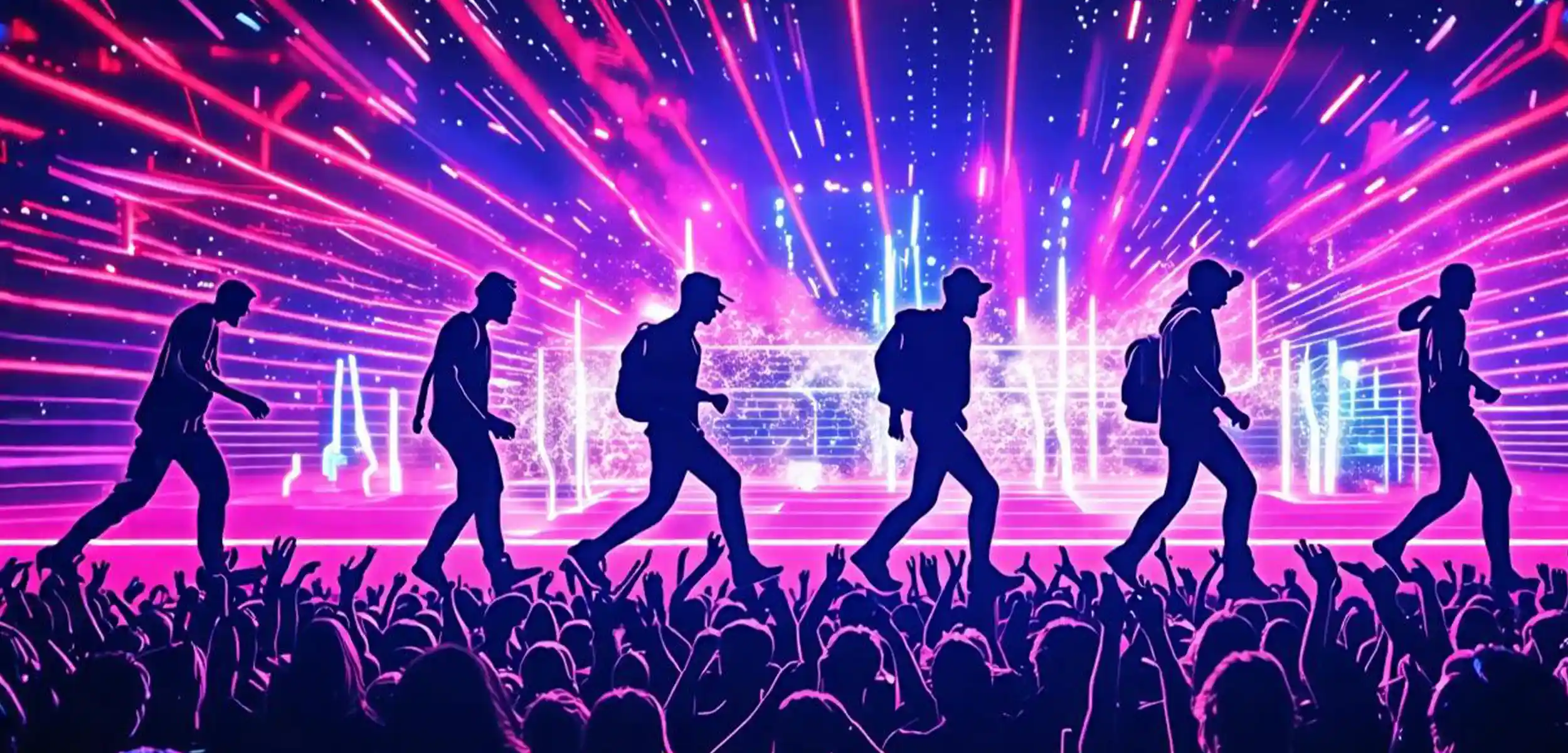In this article:
Electronic dance music (EDM) has undergone significant changes from 2014 to 2024, marked by technological advancements, diversification into new subgenres, and the impacts of the COVID-19 pandemic.
This article delves into these developments and future trends in the EDM landscape.
Key Takeaways
- EDM witnessed significant technological advancements from 2014 to 2024.
- Subgenres diversified, including the fusion with other genres.
- The COVID-19 pandemic shifted events to virtual festivals and live streams.
- Streaming services greatly impacted the distribution and consumption of EDM.
- Production and collaboration methods evolved during pandemic years.
- Current trends focus on sustainability, AI, and machine learning in music production.
- Future outlook predicts continued innovation and new trends in EDM.
The Rise of EDM (2014-2016)
Mainstream Breakthrough
Between 2014 and 2016, EDM’s popularity surged, breaking into mainstream music charts and gaining widespread recognition. Festivals like Tomorrowland and Ultra Music Festival grew in prominence, attracting massive global audiences.
EDM tracks began making regular appearances on pop radio stations. Collaborations between EDM producers and mainstream pop artists became common.
Influential Artists and Tracks
Several artists emerged as significant influencers during this period. Avicii’s “Wake Me Up,” Calvin Harris’s “Summer,” and Martin Garrix’s “Animals” were pivotal tracks that defined the era.
These artists helped shape the EDM sound. They blended catchy melodies with powerful drops, making EDM accessible to a broader audience.
Technological Advancements
Technological advancements played a critical role in EDM’s rise. Improved music production software and affordable equipment democratized the creation process, enabling more aspiring producers to enter the scene.
Innovations in sound design and music software allowed for more complex and polished productions. This pushed the genre’s sonic boundaries further.
Diversification and Subgenres (2017-2019)
Emergence of New Subgenres
From 2017 to 2019, EDM saw the birth of numerous subgenres, reflecting a growing diversity within the genre.
Future bass, a subgenre characterized by its melodic and upbeat sound, gained significant traction.
Simultaneously, tech-house, which blends the rhythms of techno and house music, rose in popularity among underground music circles.
These new styles enriched EDM’s soundscape, catering to varied listener preferences.
Fusion with Other Genres
During this period, EDM increasingly fused with other musical genres, creating innovative hybrid sounds.
Pop, hip-hop, and even country influences began appearing in EDM tracks, broadening the genre’s appeal.
Major artists like Marshmello collaborated with mainstream pop and hip-hop icons, producing crossover hits that dominated charts worldwide.
This genre-blending fostered a more inclusive and varied music scene.
Impact of Streaming Services
Streaming services like Spotify and Apple Music revolutionized how EDM was distributed and consumed.
These platforms provided unprecedented access to vast audiences, enabling smaller artists to gain visibility alongside established names.
Algorithm-driven recommendations helped listeners discover new subgenres and artists, significantly promoting EDM’s diversification.
Playlists and curated content further boosted the genre’s global reach, solidifying its presence in the digital music landscape.
The Pandemic and Its Aftermath (2020-2022)
Virtual Festivals and Live Streams
The COVID-19 pandemic forced the cancellation of physical events, leading to the rise of virtual festivals and live streams. Platforms like Twitch and YouTube became popular venues for EDM artists to reach their audiences.
Major festivals, including EDC and Tomorrowland, adapted by hosting virtual versions, featuring pre-recorded and live sets. This shift not only maintained fan engagement but also expanded the global reach of EDM, as people worldwide could attend events without travel constraints.
Changes in Production and Collaboration
The pandemic significantly altered production and collaboration methods. Artists utilized remote collaboration tools, enabling them to create music without physical studio sessions.
Digital audio workstations and cloud-based software facilitated real-time collaborative efforts. This period saw increased experimentation with new sounds and techniques, as artists had more time to focus on innovative production methods. The shift to home studios democratized music creation, allowing a broader range of artists to enter the scene.
Audience Engagement and Social Media
During the pandemic, social media became crucial for engaging with fans. Artists leveraged platforms like Instagram, TikTok, and Twitter to share updates, behind-the-scenes content, and live performances.
Interactive features such as Q&A sessions, live chats, and fan competitions fostered a sense of community despite physical distancing. The rise of short-form video content on TikTok, in particular, helped EDM tracks go viral, introducing the genre to younger audiences and sustaining its popularity.
Current Trends and Future Outlook (2023-2024)
Sustainability and Eco-Friendly Events
In 2023 and 2024, sustainability has become a major focus in the EDM scene. Festivals and events strive to reduce their ecological footprint by adopting eco-friendly practices.
Organizers are implementing measures such as:
- Solar-powered stages
- Reducing plastic usage
- Promoting recycling
This shift reflects a growing environmental consciousness and aligns EDM culture with global sustainability movements.
AI and Machine Learning in Music Production
AI and machine learning are revolutionizing music production within the EDM genre. Advanced algorithms assist in generating beats, melodies, and even mixing tracks, providing artists with new tools for creativity.
These technologies enable more precise sound design and innovative music creation processes. Producers can experiment with complex audio structures and unique sonic elements.
Predicted Trends and Innovations
Looking ahead, EDM is expected to embrace further technological advancements and diverse musical influences. Virtual and augmented reality experiences may become integral to live events, enhancing fan engagement.
Additionally, there will likely be continued exploration of hybrid genres, integrating global musical elements to create fresh, innovative sounds in the EDM landscape.
Conclusion
From 2014 to 2024, EDM evolved significantly through technological advancements, subgenre diversification, pandemic-driven virtual events, and emerging trends like sustainability and AI in music production.
The genre’s innovation and adaptability foresee sustained growth and continued influence.
Read other articles
 June 23, 2025
June 23, 2025Feeling vs Technique in Music Production
Feeling vs Technique in Music Production
 June 4, 2025
June 4, 2025The Rise of the Middle Eastern Sound and its Impact on EDM
The Rise of the Middle Eastern Sound and its Impact on EDM
 April 4, 2025
April 4, 2025Stop Letting AI Master Your Tracks (Here’s What You’re Missing)
Stop Letting AI Master Your Tracks (Here’s What You’re Missing)

